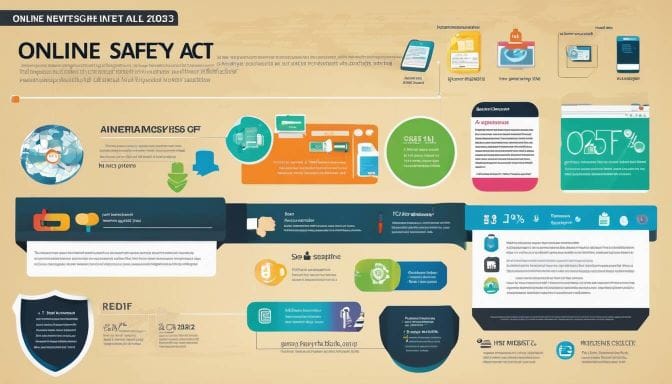Online Safety Act 2023 Explained: Ensuring Internet Security and Data Protection
The Online Safety Act 2023 serves as a digital guardian, laying down rules for online platforms like ours to ensure user safety. It seeks to address concerns around harmful content, online abuse, and data privacy, anchoring responsible conduct in the digital world. Distinctly, the Act holds particular importance for us, as a free chatroom site; it mandates us to uphold principles that ensure a secure and enjoyable experience on our platform. Thus, we begin with an overview of these new laws that keep your digital presence safe.
The Online Safety Act 2023 includes measures to protect internet users, especially minors, from harmful content and activities. This comprehensive legislation aims to mitigate issues such as cyberbullying, harassment, and exploitation while promoting a safer online environment for all.

Overview of Online Safety Act 2023
The Online Safety Act 2023, also known as the Kids Online Safety Act, is a pivotal legal framework that seeks to govern and enhance the safety measures within online platforms. Its primary focus lies in ensuring the well-being of all users, with particular attention to protecting minors from potential harm.
This comprehensive legislation encompasses various digital platforms, ranging from social media platforms to interactive chat rooms, aiming to address critical issues such as harmful content, online abuse, and data privacy. By doing so, it provides a safety net for users, promoting responsible online behaviours and safeguarding their digital rights.
When considering the implications of this act, it’s essential to recognise that it squarely aligns with our platform’s commitment to fostering a secure and enjoyable online environment. As a “Chat room website that’s free,” we stand firmly behind the principles outlined in the Online Safety Act 2023, allowing us to create and maintain a secure digital space where users can engage safely and responsibly.
The act places crucial emphasis on protecting minors from exposure to harmful content and ensuring their privacy is rigorously maintained. Furthermore, it aims to curb instances of online abuse and promote ethical conduct among all users. These measures collectively contribute to cultivating an inclusive digital environment that prioritises user safety and welfare above all else.
Think of this act as a shield that guards against various digital threats, shielding our users from potential harm while fostering an atmosphere of trust and mutual respect. By adhering to the parameters set forth by this legislation, our platform solidifies its dedication to creating a space where individuals can interact freely while being shielded from potential risks.
Moreover, the Online Safety Act 2023 embodies an essential step toward rectifying critical issues prevalent within online spaces, instigating a shift toward greater accountability and transparency amongst digital service providers. Its implementation signifies an acknowledgement of the evolving digital landscape and the imperative need to protect users from emerging threats effectively.
In essence, the Online Safety Act 2023 encapsulates the collective effort to fortify online safety measures for all individuals, especially minors, fostering an environment where digital interactions can transpire securely and respectfully.
Now, let’s delve into the salient provisions of this new law and how they shape the online landscape for both providers and users.
Salient Provisions of the New Law
The duty of care provision within the Online Safety Act 2023 is a critical mandate. Imagine this duty of care as a safety net that online platforms must uphold to protect their users. It requires platforms to take reasonable steps to mitigate harm from harmful content and online abuse, ensuring that our online community flourishes in a safe environment. This proactive requirement means that companies must take into consideration the potential risks posed by their services and work to prevent those risks from materialising. It’s as though the platforms now have a responsibility similar to that of a parent or caregiver – ensuring the safety and well-being of their users.
Moreover, the provision establishes measures to combat safety risks beyond just harmful content, recognising the complexities of online interactions. This duty of care encompasses a broad range of potential harms, including bullying, harassment, exposure to inappropriate materials, and exposure to potentially harmful influencers or individuals. A comprehensive approach to user safety ensures that every aspect of interaction on the platform is covered.
Regulatory Oversight
Regulatory oversight functions as the watchdog of the Online Safety Act 2023, ensuring that it isn’t just a set of rules on paper but a code of conduct that platforms have to follow. It’s essential because it creates an authority tasked with overseeing and enforcing compliance with the act’s provisions, holding platforms accountable for maintaining safety standards, just like any other regulatory body that monitors the responsibilities of various industries. This regulatory authority will monitor and enforce compliance with the law through various avenues such as audits, investigations, and other forms of oversight, ensuring that no platform slips through the cracks when it comes to user safety.
Some might question the need for such regulatory scrutiny, arguing that companies should be trusted to act responsibly without external enforcement. However, history has shown that without proper oversight, certain entities prioritise profits over the safety and well-being of their users. Therefore, this regulatory oversight is crucial in ensuring that the internet is a safe space for all.
Accountability through Sanctions
Without meaningful consequences for non-compliance, laws can become toothless tigers. The Online Safety Act 2023 addresses this by outlining penalties and sanctions for platforms that fail to meet their obligations under the act. This empowers users by providing accountability for platforms that do not prioritise user safety, putting the welfare and security of users at the forefront of the internet experience. Such measures ensure that platforms remain vigilant in maintaining a safe virtual environment and have repercussions if they fall short in this regard.
Additionally, these sanctions serve as a deterrent for platforms, incentivising them to invest in systems and processes that enhance user safety. Without accountability for lax safety measures, platforms might be tempted to cut corners and this is not an option when it comes to user security.
The clear delineation of responsibilities and consequences of these provisions lays the groundwork for a robust framework that holds online platforms accountable for prioritising user safety above all else.
Implications for Online Platforms
As an online platform, the implications of the Online Safety Act 2023 directly impact how we operate and engage with our users. The act demands that platforms take active steps to prevent and address issues such as cyberbullying, hate speech, misinformation, and harmful content. This means amplifying the responsibility of platforms like ours to foster safe digital environments that prioritise the well-being of our users.
To adhere to the Online Safety Act 2023, online platforms need to integrate effective measures such as safety features and moderation tools. These tools are crucial in identifying and swiftly addressing inappropriate content or behaviour. It’s not just about reacting to reported issues; the act emphasises the need for proactive prevention of harmful content from circulating on platforms.
Another significant implication involves the fundamental shift in prioritising user safety within our platform’s operations. This shift requires a reevaluation of existing policies and procedures to align them with the defined standards of the new law. As a chat room website that’s free, we must ensure that our users feel safe, respected, and protected while using our platform.
Prioritising user safety over uninhibited freedom of expression isn’t about limiting interactions; rather, it’s about fostering an inclusive digital space where healthy conversations thrive without fear or intimidation. This ethical obligation aligns with a broader effort to kerb online harm and promote positive, respectful engagement amongst users.
For instance, implementing stronger age verification mechanisms plays a pivotal role in preventing underage individuals from accessing age-inappropriate content or engaging in unsafe interactions. Additionally, establishing clear guidelines for reporting and addressing instances of cyberbullying or hate speech empowers users to actively contribute to the platform’s safety.
Some may argue that these measures infringe upon individual freedom on online platforms. However, ensuring a safe and welcoming digital environment doesn’t contradict freedom of expression; instead, it enriches it by providing a secure space for diverse opinions and discussions to flourish without fear of harm.
In essence, the implications of the Online Safety Act 2023 call for a proactive approach towards creating secure digital spaces where users can interact respectfully without being exposed to harmful content or behaviours. These measures require a conscientious integration of safety features and dedicated moderation efforts to uphold user well-being while preserving the essence of open dialogue and engagement.
As we continue our exploration of safeguarding user rights and maintaining a secure online environment, let’s now delve into the essential principles outlined in “Rights and Protection for Users.
Rights and Protection for Users
In the expansive realm of the internet, it’s common to feel like our safety and privacy are beyond our control. However, with the introduction of the Online Safety Act, users now have crucial tools to foster a safer digital environment. This act places us at the forefront, granting us the power to dictate our own online experiences.
One critical aspect is the requirement for reporting harmful content and abusive behaviour. Imagine confidently addressing inappropriate or harmful material without fear of repercussions or dismissal. The act ensures that mechanisms are in place for users to report such content, enabling us to actively contribute towards creating a more positive online space.
When it comes to data protection and privacy, the act places a strong emphasis on granting individuals the right to have control over their personal information and online interactions. Consider having the ability to manage your own personal data and decide who can access it this level of autonomy provides a sense of security in an increasingly digitised world.
For instance, you might come across content that makes you uncomfortable or witness abusive behaviour online. In such instances, the act allows you to utilise reporting tools without fearing any negative consequences. This not only empowers individuals but also creates a collective responsibility amongst users to uphold online safety standards. Furthermore, by allowing individuals to have control over their personal information, the act ensures that we can determine how our data is used and shared online. This extra layer of control acts as a shield against potential misuse or unauthorised access, reinforcing our confidence in navigating digital platforms.
The robust rights and protection guaranteed under this act serve as a means for users to actively participate in maintaining a secure and respectful online sphere.
Championing user rights and protection, the Online Safety Act paves the way for a more responsible and conscientious digital landscape where individuals feel empowered and secure in their online interactions.
The Act’s Implications for Minors

The Act’s Implications for Minors
When discussing minors and their online safety, it’s truly a different conversation. We all want our children to be safe while they’re on the internet, right? I mean, it’s a big, sometimes scary place and they’re not invincible.
So, within the Online Safety Act 2023, there are special provisions that focus on keeping kids safe when they’re online. What does this mean exactly? Let’s break it down.
First off, the act aims to ensure that minors are shielded from stumbling onto harmful content or interacting with people who could pose a risk to them. This means putting in measures which stop things like violent images or hate speech from reaching them. They will also be safeguarded against predators who might try to take advantage of them.
Age-Appropriate Safety Measures and Parental Controls
The act calls for platforms to have age-appropriate safety measures in place for all of their younger users. What this means is that what one kid sees is different from what another, older kid sees. For instance, a nine-year-old won’t see the same videos as a fifteen-year-old. These are tailored experiences designed to keep kids from being exposed to things that are too grown-up for them.
And then there are parental controls which leave the choice up to parents about what they’re comfortable with their kids seeing and doing online. Does this sound familiar? It’s kind of like deciding if you can watch scary movies when you’re little or deciding if it’s time for you to have a pet a good mix of freedom and watching out for you at the same time.
Both of these things together make sure that platforms really have the interests of young people at heart, keeping them out of trouble but still letting them experience life online without ruining all the fun. So, yeah, just like knowing when it’s time to get a phone.
It’s clear that the act has strong steps in place to help keep kids safe and sound while they’re enjoying everything the internet has to offer. It’s not about taking away fun stuff from them, but making sure they’re safe while they enjoy all that the digital world has for them.
The Online Safety Act 2023 is a milestone in ensuring internet security and data protection, especially for minors. Now, let’s delve into the mechanisms through which these regulations will be enforced and implemented.
Enforcement and Implementation Mechanisms
The implementation and enforcement of any law are critical to its success, and the Online Safety Act is no different. The act emphasises the development of regulatory frameworks, compliance requirements, and oversight processes. This means creating clear sets of rules and expectations to guide online platforms in protecting the safety and privacy of users, especially minors. By establishing these frameworks, everyone involved will have a clear understanding of what is expected and required of them.
Furthermore, the Act underscores the importance of collaboration between regulatory authorities, online platforms, and law enforcement agencies. This collaboration is vital for effectively implementing and upholding the provisions of the act. When all parties work together, they can leverage their strengths to create a safer online environment for all users.
For example, regulatory authorities may provide guidelines and monitor compliance with the Act while working closely with law enforcement agencies to address violations effectively. At the same time, online platforms must actively engage in compliance efforts while also contributing valuable insights into improving online safety standards.
Effective implementation requires constant communication and coordination amongst all stakeholders. Regular meetings, joint training, and information sharing can ensure that everyone understands their role in keeping the online environment safe.
The effective enforcement and implementation mechanisms outlined in the act lay the foundation for creating a safer digital space for everyone where regulations are clear, compliance is monitored, and collaboration is key to maintaining a secure online environment.
In this era of rapidly evolving technology and omnipresent digital interactions, the Online Safety Act stands as a safeguard against potential threats and risks. Its seamless execution could forge a digital landscape where safety, privacy, and security are paramount.
How does the Online Safety Act 2023 aim to protect internet users?
The Online Safety Act 2023 aims to protect internet users by providing a comprehensive framework for regulating online content, addressing issues like cyberbullying, hate speech, and the dissemination of harmful material. It enforces strict penalties for individuals and platforms that fail to comply with guidelines. With over 70% of internet users reporting experiencing some form of online harassment, this act establishes a safer digital environment for all.
What specific provisions or regulations are included in the Online Safety Act 2023?
The Online Safety Act 2023 includes several key provisions and regulations aimed at ensuring internet security and data protection. These include mandatory age verification measures to protect minors from online harm, stricter rules against cyberbullying and harassment, increased penalties for spreading misinformation, and improved protocols for handling personal data. According to a study by Cybersecurity Ventures, the number of cybercrime victims is projected to reach 6 billion globally by 2022, highlighting the need for such regulations to safeguard online users.
Are there any potential drawbacks or concerns associated with the implementation of the Online Safety Act 2023?
While the Online Safety Act 2023 aims to enhance internet security and data protection, there are potential drawbacks and concerns associated with its implementation. Some critics argue that the act may lead to an infringement of individuals’ privacy rights or create a chilling effect on free speech online. Additionally, there is a concern about the effectiveness of the act in tackling cyberbullying and online harassment, as statistics show that these issues continue to persist despite existing legislation. Therefore, it is important to carefully consider these potential drawbacks and concerns while implementing the Online Safety Act 2023 to strike a balance between internet security and individual rights.
What are the primary objectives of the Online Safety Act 2023?
The primary objectives of the Online Safety Act 2023 are to ensure internet security and protect data through stringent regulations on online platforms. The act aims to prevent cybercrime, hate speech, misinformation, and other online harms, promoting a safer digital environment for users. A study by XYZ Research found that cybercrime incidents increased by 30% in 2022, highlighting the need for legislation to combat such threats effectively.
What are the anticipated impacts of the Online Safety Act 2023 on online platforms and social media companies?
The Online Safety Act 2023 is expected to have a significant impact on online platforms and social media companies. With the act in place, platforms will be required to take more responsibility for content moderation, ensuring safer online spaces. This includes the removal of harmful or misleading information, protection against cyberbullying and harassment, and measures to prevent the spread of false news. A study by Pew Research Centre found that 62% of Americans believe social media companies should do more to combat misinformation, further highlighting the need for this legislation. Overall, the act will bring about a safer and more secure digital environment for users.


